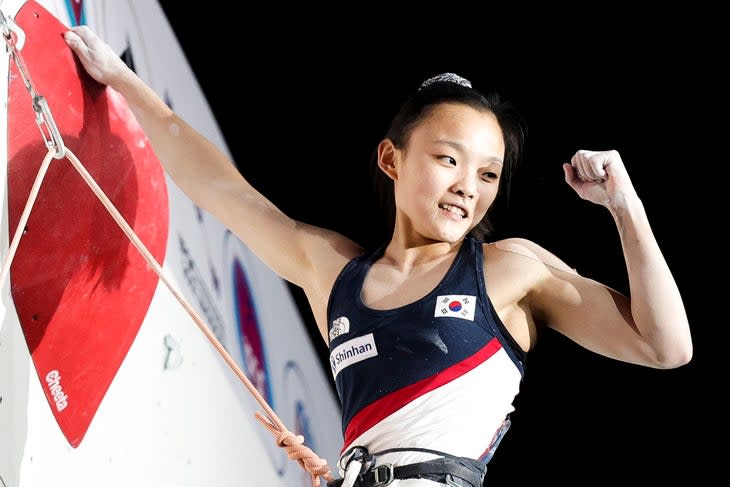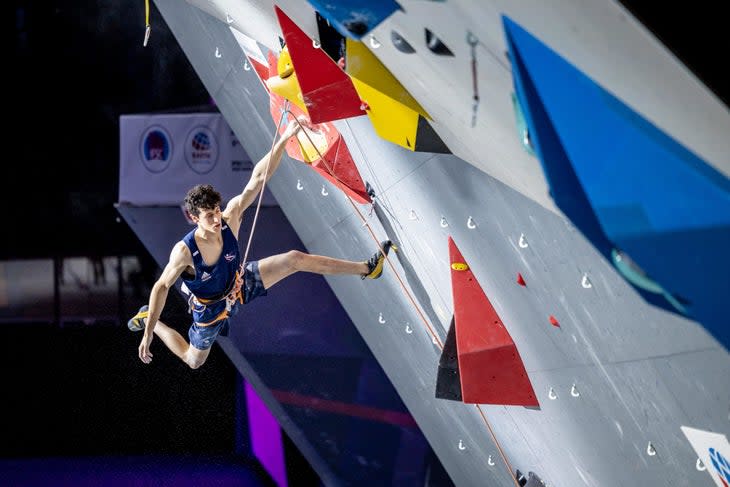Dramatic End to the World Championships Results in More American Hardware
The IFSC's World Championships concluded today in Moscow with the men's and women's Lead discipline. The events marked the rather sudden and unexpected end to the 2021 Speed, Boulder, and Lead seasons (more on this below). Still, at least things finished on a high note, with the Lead portion of the World Championships featuring some of the most dramatic climbing of the entire year...and another medal added to Team USA's trophy case.
In the women's division, both Brooke Raboutou and Natalia Grossman of Team USA finished the Lead qualification round in the Top 5 to cruise into the semifinals. Brooke Raboutou climbed first in the semis and fell on the headwall as she attempted to grasp a screw-on jib (hold 40). Moments later, Grossman climbed and was able to stick the cruxy move and continue to the top of the route. But Italy's Laura Rogora and South Korea's Chaehyun Seo topped the semifinal route as well, to set up a highly competitive final round.
In the finals, Grossman charged through the wall's lower section of dual-tex pinches and into the headwall's pinches, falling only when her right-foot smeared and slipped off a slopey volume. In the round's most heart-pounding moment, Rogora climbed and fell in the exact same spot (hold 37). This tie at hold 37 meant that Grossman and Rogora would be separated in the scores by their time on the wall--with Grossman having climbed slightly quicker (4:22, compared to 5:01), thus earning a higher place. As stellar as Grossman's performance was, it was soon bested by Seo, who stayed secure through the headwall's volumes--no foot slips whatsoever--and topped the route. "Sometimes you just have that x-factor, that little extra thing," commentator Matt Groom said of Seo as he deemed her top of the route a "masterclass." Grossman finished with the silver medal, with Rogora earning the bronze. Austria's Jessica Pilz finished in fourth place, narrowly missing out on the podium, with Raboutou finishing in fifth place.
The men's division saw a budding rivalry between Great Britain's 19-year-old standout Hamish McArther and IFSC circuit veteran Jakob Schubert of Austria. McArthur and Schubert finished in first- and second-place, respectively, in the semifinals, and their fierce duel carried over into the finals.
Schubert easily stuck a crowd-pleasing dyno low on the wall in the finals, then found some flow in the mid-section of dual-tex slopers and gritted through the "nest of crimps" on the headwall to secure a top. Slovenia's Luka Potocar, amid a breakout season that included a second-place finish at the Kranj World Cup, also topped the men's route. McArthur appeared to be on his way to doing the same, but his left-hand dry-fired as he launched for the top hold. The crowd gasped as McArthur fell from the wall, having to settle for the bronze medal. Schubert took the gold (and, as such, the third Lead World Championship win of his career, having also won in 2012 and 2018) and Potocar earned the silver.
Here are some other Highs, Lows, and Miscellany from the wild Lead rounds in Moscow.

HIGHS
The real deal: A little more credit is due to Chaehyun Seo. The 17-year-old first garnered attention a few years ago when she sent 5.14d as a 14-year-old. Then, she made headlines in 2019 when she beat Janja Garnbret a number of times on the World Cup circuit. Seo also qualified for the Olympics (and made finals). And on top of a World Championship this year, Seo podiumed at the Kranj World Cup. Not bad for someone who has only been on the adult circuit for about a year, huh?
Dyno drama: I mentioned above that Schubert easily stuck the dyno low on the men's route in the finals. But there were a number of men that were more troubled by it. For example, Italy's Stefano Ghisolfi took a lot of preparatory swings and the commentators noted he was trying to figure out the best beta. And Luka Potocar and the Czech Republic's Martin Stranik both slipped while setting up for the dyno, although they were each able to recover. The dyno didn't prove to be a total stopper move for any competitor, but it certainly was not a gimme for anyone.

The no-look jump: Speaking of dynos, there was a big jump on the women's route in the finals too. Two highlights come to mind. First, it was surprising when Jessica Pilz did the dyno totally statically. But it was even more dazzling when Brooke Raboutou chose to not dyno to the visible hold, instead latching a hold that was hidden behind a large blue volume. I'm not sure what to credit more, Raboutou's experience or audacity in choosing to launch for that concealed hold, but it sure was exciting.
Hands-free: How about that no-hands rest that Germany's Sebastian Halenke found on the headwall below the collection of yellow crimps? He looked totally secure there, perched on the red volume and able to shake out with ease. No other competitor even attempted to rest there. As Matt Groom said on commentary, "I would bet money the routesetters had no idea that was possible."
Style makes the climb: When describing the climbing of Bulgaria's Aleksandra Totkova during the women's semifinal, Matt Groom said, "It's almost like everything you're taught not to do." And it's true, Totkova seems to cut her feet from the wall with reckless abandon and she has a noticeably jerky style. But this anti-style also makes her so fun to watch; every move is more dramatic than it would be if performed with a bit more fluidity. Consider me a fan.

LOWS
No double gold: I couldn't help but think that magic was going to happen for Japan's Kokoro Fujii. Just a day after winning gold in the men's Boulder discipline, he looked fantastic during Lead qualification and finished the round situated in third place behind his compatriot, Tomoa Narasaki, and Hamish McArthur. I started to believe that Fujii might actually do what Slovenia's Janja Garnbret did at the 2019 World Championships and win both Boulder and Lead. As it turned out, that wasn't meant to be. Fujii fell low while going for a left-hand jib in the Lead semifinals and didn't advance to the finals. Still, he earned some gold hardware at the World Championships by putting on one of the most dominant men's Boulder performances we've ever seen in a World Championship, so he has to feel good about that.
The competitive soul: South Korea's Hyunbin Min is 32 years old--an age when many competitors would already be retired from the IFSC circuit. Yet, he revealed prior to the competition that he is not ready "in his soul" to be done competing. That's deep. It's unfortunate that he fell while going dynamically for a right-hand crimp during the men's semifinals and didn't advance to finals, but I still found myself thinking a lot about his quote and his enduring desire to stay on the circuit. Good for him.
Wait, tell us more: Matt Groom indicated on commentary that there were a lot of appeals following the semifinals, but he did not go into any details. "There was a bit of up and down about who exactly was in the finals--I'll leave all that debate to the coaches and the judges," Groom said on the livestream, thus leaving viewers in the dark about it all. To stay mum on the subject like that was an odd choice. Explaining appeals and judgments that have happened off-screen is precisely the type of thing that the commentator should do. Why shy away from it?
Another shortened season: As referenced above, amid all this World Championship action, the IFSC announced that the Speed and Boulder World Cup that was scheduled to take place in Seoul, South Korea, next month has been cancelled. At the time of this writing, the Los Angeles Paraclimbing World Cup (which is also scheduled to take place next month), is still a go. But this is not how anyone wanted to see the epic 2021 season conclude--with not only the cancellation of that event in Seoul, but also the cancellation of World Cups in Xiamen, Wujiang, and Jakarta. We have now had multiple seasons significantly altered and truncated by the pandemic. Here's hoping for a healthier future and a full season next year.
MISCELLANEOUS
I'm glad that Team USA's Sean Bailey is taking some time to climb outdoors in Europe and work on whatever routes have him stoked. But, dang, after the incredibly decorated competition season he has had (with gold medals in the Lead and Boulder disciplines), I would have loved to see what he could have done on these lead routes at the World Championships.
Also, did you notice that the men's semifinal concluded with four competitors still to climb in the women's semifinal? That was the difference between a women's route that included multiple rest spots and a men's route that was practically a non-stop blitz. From a viewing standpoint, I found it engaging to have such a stylistic difference between the routes.
Finally, in addition to Grossman and Raboutou, members of Team USA finished as follows. In the women's division: Kylie Cullen placed 28th, Cloe Coscoy placed 37th, and Quinn Mason placed 49th. In the men's division, Ross Fulkerson placed 36th, Ellis Ernsberger tied for 42nd, Ben Hanna placed 58th, and Isaac Leff placed 64th.
RESULTS
Women
Chaehyun Seo (KOR)
Natalia Grossman (USA)
Laura Rogora (ITA)
Jessica Pilz (AUT)
Brooke Raboutou (USA)
Natsuki Tanii (JPN)
Dinara Fakhritdinova (CFR)
Salome Romain (FRA)
Men
Jakob Schubert (AUT)
Luka Potocar (SLO)
Hamish McArthur (GBR)
Martin Stranik (CZE)
Tomoa Narasaki (JPN)
Sebastian Halenke (GER)
Yoshiyuki Ogata (JPN)
Stefano Ghisolfi (ITA)
This article is free. Sign up with a Climbing membership, now just $2 a month for a limited time, and you get unlimited access to thousands of stories and articles by world-class authors on climbing.com plus a print subscription to Climbing and our annual coffee-table edition of Ascent. Please join the Climbing team today.
For exclusive access to all of our fitness, gear, adventure, and travel stories, plus discounts on trips, events, and gear, sign up for Outside+ today.


